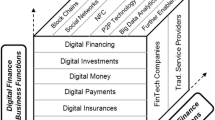Abstract
The number of innovative financial solutions introduced to markets has grown considerably in the past decade owing to emerging digital technologies, deregulation and market fragmentation. Examples are abundant in the worldwide markets for insurance, credit products and transaction processing services. A question of growing interest is how firms should price these innovations. The optimal introductory pricing of financial innovations may vary as a function of factors such as price sensitivity of the market and competitors’ ability to introduce competing financial solutions. In this article, we examine the role of these factors in the optimal pricing of a financial innovation. Using an agent-based simulation framework, introductory pricing strategies that maximize profitability under various market conditions are identified. Results indicate that lower levels of market price sensitivity and longer time horizons for competitive entry create pricing opportunities for financial innovators. However, the relationship becomes more complex as market price sensitivity increases or competitive market entry becomes more immediate. Detailed recommendations for optimal pricing of financial innovations under various market conditions are provided, and the article concludes with strategic recommendations for pricing innovative financial services.

Similar content being viewed by others
References
Amini, M., Wakolbinger, T., Racer, M. and Nejad, M.G. (2012) Alternative supply chain production–sales policies for new product diffusion: An agent-based modeling and simulation approach. European Journal of Operational Research 216 (2): 301–311.
Bass, F. (1969) A new product growth model for consumer durables. Management Science 15 (5): 215–227.
Bass, F. (2004) Comments on ‘a new product growth for model consumer durables’. Management Science 50 (12): 1825–1832.
Bijmolt, T., Van Heerde, H. and Pieters, R. (2005) New empirical generalizations on the determinants of price elasticity. Journal of Marketing Research 42 (2): 141–156.
Casalo, L., Flavian, C. and Guinaliu, M. (2008) The role of satisfaction and website usability in developing customer loyalty and positive word-of-mouth in the e-banking services. International Journal of Bank Marketing 26 (6): 399–417.
Chandrasekaran, D. and Tellis, G. (2007) A critical review of marketing research on diffusion of new products. In: N.K. Malhotra (ed.) Review of Marketing Research. Armonk: M.E. Sharpe, pp. 39–80.
Chen, Y., Wang, Q. and Xie, J. (2011) Online social interactions: A natural experiment on word of mouth versus observational learning. Journal of Marketing Research 48 (2): 238–254.
Davis, J., Eisenhardt, K. and Bingham, C. (2007) Developing theory through simulation models. Academy of Management Review 32 (2): 480–499.
Dawes, J., Mundt, K. and Sharp, B. (2009) Consideration sets for financial services brands. Journal of Financial Services Marketing 14 (3): 190–202.
Dusansky, R. and Koc, C. (2010) Implications of the interaction between insurance choice and medical care demand. Journal of Risk and Insurance 77 (1): 129–144.
Estelami, H. (1999) The profit impact of consumer complaint solicitation across market conditions. Services Marketing Quarterly 20 (1): 165–195.
Estelami, H. (2005) A cross-category examination of consumer price awareness in financial and non-financial services. Journal of Financial Services Marketing 10 (2): 125–139.
Estelami, H. (2006) Marketing Financial Services. Indianapolis, IN: Dog Ear Publishing.
Estelami, H. (2009) Cognitive drivers of suboptimal financial decisions: Implications for financial literacy campaigns. Journal of Financial Services Marketing 13 (4): 273–283.
Fortin, D. and Uncles, M. (2011) The first decade: Emerging issues of the twenty-first century in consumer marketing. Journal of Consumer Marketing 28 (7): 472–475.
Ghoreishi Nejad, M. (2011) The role of influentials in the diffusion of new products: PhD dissertation, University of Memphis, Memphis, TN, USA.
Gladwell, M. (2002) The Tipping Point: How Little Things Can Make a Big Difference. San Francisco, CA: Back Bay Books.
Goldenberg, J., Libai, B., Moldovan, S. and Muller, E. (2007) The NPV of bad news. International Journal of Research in Marketing 24 (3): 186–200.
Goldenberg, J., Libai, B. and Muller, E. (2002) Riding the saddle: How cross-market communications can create a major slump in sales. Journal of Marketing 66 (2): 1–16.
Gounaris, S., Stathakopoulos, V. and Athanassopoulos, A. (2003) Antecedents to perceived service quality: An exploratory study in the banking industry. International Journal of Bank Marketing 21 (4/5): 168–190.
Harrington, J. (2011) Customer satisfaction dips for banks, soars for credit unions. Tribune Business News, 13 December: 8.
Harrison, J.R., Zhiang, L.I.N., Carroll, G.R. and Carley, K.M. (2007) Simulation modeling in organizational and management research. Academy of Management Review 32 (4): 1229–1245.
Hogan, J., Lemon, K.N. and Libai, B. (2003) What is the true value of a lost customer? Journal of Service Research 5 (3): 196.
Jiang, Z., Bass, F. and Bass, P. (2006) Virtual Bass model and the left-hand data-truncation bias in diffusion of innovation studies. International Journal of Research in Marketing 23 (1): 93–106.
Krishnan, T., Bass, F. and Kumar, V. (2000) Impact of a late entrant on the diffusion of a new product/service. Journal of Marketing Research 37 (2): 269.
Lehmann, D. and Esteban-Bravo, M. (2006) When giving some away makes sense to jump-start the diffusion process. Marketing Letters 17 (4): 243–254.
Libai, B., Muller, E. and Peres, R. (2009) The diffusion of services. Journal of Marketing Research 46 (2): 163–175.
Libai, B., Muller, E. and Peres, R. (2010) Sources of Social Value in Word-of-Mouth Programs. in MSI Working Paper Series. Report no.10–103.
Lilien, G.L., Rangaswamy, A. and Van den Bulte, C. (2000) Diffusion models: Managerial applications and software. In: V. Mahajan, E. Muller and Y. Wind (eds.) New-product Diffusion Models. New York: Kluwer Academic Publishers.
Lowenstein, G. and Thaler, R. (1989) Anomalities: Intertemporal choices. Journal of Economic Perspectives 3 (4): 181–193.
Manning, R. (2001) Credit Card Nation: The Consequences of America's Addiction to Credit. New York: Basic Books.
Mesak, H. and Darrat, A. (2002) Optimal pricing of new subscriber services under interdependent adoption processes. Journal of Service Research 5 (2): 140–153.
Muller, E., Peres, R. and Mahajan, V. (2010) Innovation Diffusion and New Product Growth. Cambridge, MA: Marketing Science Institute.
Murray, K. (1991) A test of services marketing theory: Consumer information acquisition activities. Journal of Marketing 55 (1): 10.
Murthi, B., Steffes, E. and Rasheed, A. (2011) What price loyalty? A fresh look at loyalty programs in the credit card industry. Journal of Financial Services Marketing 16 (1): 5–13.
North, M. and Macal, C. (2007) Managing Business Complexity. New York: Oxford University press.
Oliver, R. (2009) Satisfaction: A Behavioral Perspective on the Consumer. New York: M.E. Sharpe.
Panther, T. and Farquhar, J. (2004) Consumer response to dissatisfaction with financial services providers: An exploration of why some stay while others switch. Journal of Financial Services Marketing 8 (4): 343–353.
Richards, J. (2009) Common fallacies in law-related consumer research. Journal of Consumer Affairs 43 (1): 174–180.
Rogers, E. (2003) Diffusion of Innovations, 5th edn. New York: Free Press.
Shleifer, A. (2000) Inefficient Markets: An Introduction to Behavioral Finance. New York: Oxford University Press.
Sultan, F., Farley, J.U. and Lehmann, D.R. (1990) A meta-analysis of applications of diffusion models. Journal of Marketing Research 27 (1): 70–77.
Tellis, G. (1998) The price elasticity of selective demand: A meta-analysis of econometric models of sales. Journal of Marketing Research 25 (4): 331–341.
Toubia, O., Goldenberg, J. and Garcia, R. (2008) A New Approach to Modeling the Adoption of New Products: Aggregated Diffusion Models. MSI Working Paper Series, 08 (001), pp. 65–81.
Van den Bulte, C. and Wuyts, S. (2007) Social Networks and Marketing. Cambridge, MA: Marketing Science Institute.
Walker, O., Mullins, J. and Boyd, H. (2010) Marketing Strategy: A Decision Focused Approach. New York: McGraw-Hill.
Warren, E. (2008) Product safety regulation as a model for financial services regulation. Journal of Consumer Affairs 42 (3): 452–460.
Author information
Authors and Affiliations
Corresponding author
Additional information
3Both authors contributed equally to this paper
APPENDIX
APPENDIX
Selection of parameter values for the simulation model
Price, price elasticity and time horizon
The simulation examines diffusion processes resulting from sales prices of 0.4, 0.7, 1 (base level), 1.3 and 2. In addition, price elasticity is systematically varied at four levels: 0.2, 0.6, 1 and 2. These values are in line with those used in previous theoretical studies (for example, Lehmann and Esteban-Bravo, 2006) and those found in meta-analysis of empirical studies (Tellis, 1998; Bijmolt et al, 2005).
To capture the expected time of competitive entry, we applied the customer groups discussed by Rogers (2003) in the base model. Rogers categorizes adopters into five categories: innovators, early adopters, early majority, late majority and laggards. We examined the time horizons of 3, 6, 9 and 12 periods. These numbers represent the average time when approximately 3 per cent, 16 per cent, 50 per cent and 84 per cent of the market have adopted the product in the base case. These values approximately represent the cumulative adoption of the four first groups of the aforementioned categories of adopters as discussed by Rogers (2003). Furthermore, because increasing price may lead to slower adoption rates, and hence longer diffusion patterns, we also captured the dependent variable at a time when 95 per cent of the market have adopted the product. This allowed for examining conditions where the firm does not have any concern with the amount of time it may take for the diffusion process to complete and the goal is to maximize profits regardless of the time horizon.
Parameters p and q
The values of parameters p and q are based on the values estimated by previous empirical research and meta-analyses. As this study seeks to examine the context of financial innovations, the choices of values for parameters p and q represent average values considered for such an innovation in previous research. Thus, we fixed the aggregate-level parameter p to 0.0142 and the aggregate-level parameter q to 0.545, values estimated for the diffusion of online banking (Libai et al, 2009). These values are in line with those used in earlier studies that examined online banking (Hogan et al, 2003). Moreover, previous research has found that consumers perceive greater risk in the adoption of services compared to the adoption of goods, and thus adoption of services relies more heavily on WOM and personal sources of information, and less so on information from marketers (Murray, 1991). Therefore, the choice of the two parameters in this study are in line with the average values estimated in previous meta-analysis studies (Sultan et al, 1990; Jiang et al, 2006).
The aggregate-level values of parameters p and q were converted to the individual-level parameters p i and q i using the methods suggested in the literature (Goldenberg et al, 2002; Toubia et al, 2008). The parameter p is the same at both aggregate and individual levels. However, the individual-level value of parameter q is calculated by dividing the aggregate-level value of parameter q by the number of individual ties. Therefore, the overall diffusion process resulting from this model are comparable to those at the aggregate level (Goldenberg et al, 2002).
Fixed variables
We fixed the average number of one-to-one connections between one consumer and other consumers to 14, a value that is in line with the average number found in previous studies (Goldenberg et al, 2007; Libai et al, 2010; Ghoreishi Nejad, 2011). For the purposes of the simulation, we fixed the market size – number of potential consumers – to 3000, a value that is in line with earlier studies (for example, Goldenberg et al, 2007; Ghoreishi Nejad, 2011). Furthermore, because the average number of connections is used in converting the aggregate-level value of q into individual-level values, it is also indirectly captured in the diffusion process through the influence of consumers on each other through q i , the number of social ties does not significantly alter the results (Ghoreishi Nejad, 2011). It is important to note that we further examined values of 4 and 24 and the results remained the same.
Rights and permissions
About this article
Cite this article
Nejad, M., Estelami, H. Pricing financial services innovations. J Financ Serv Mark 17, 120–134 (2012). https://doi.org/10.1057/fsm.2012.12
Received:
Revised:
Published:
Issue Date:
DOI: https://doi.org/10.1057/fsm.2012.12




